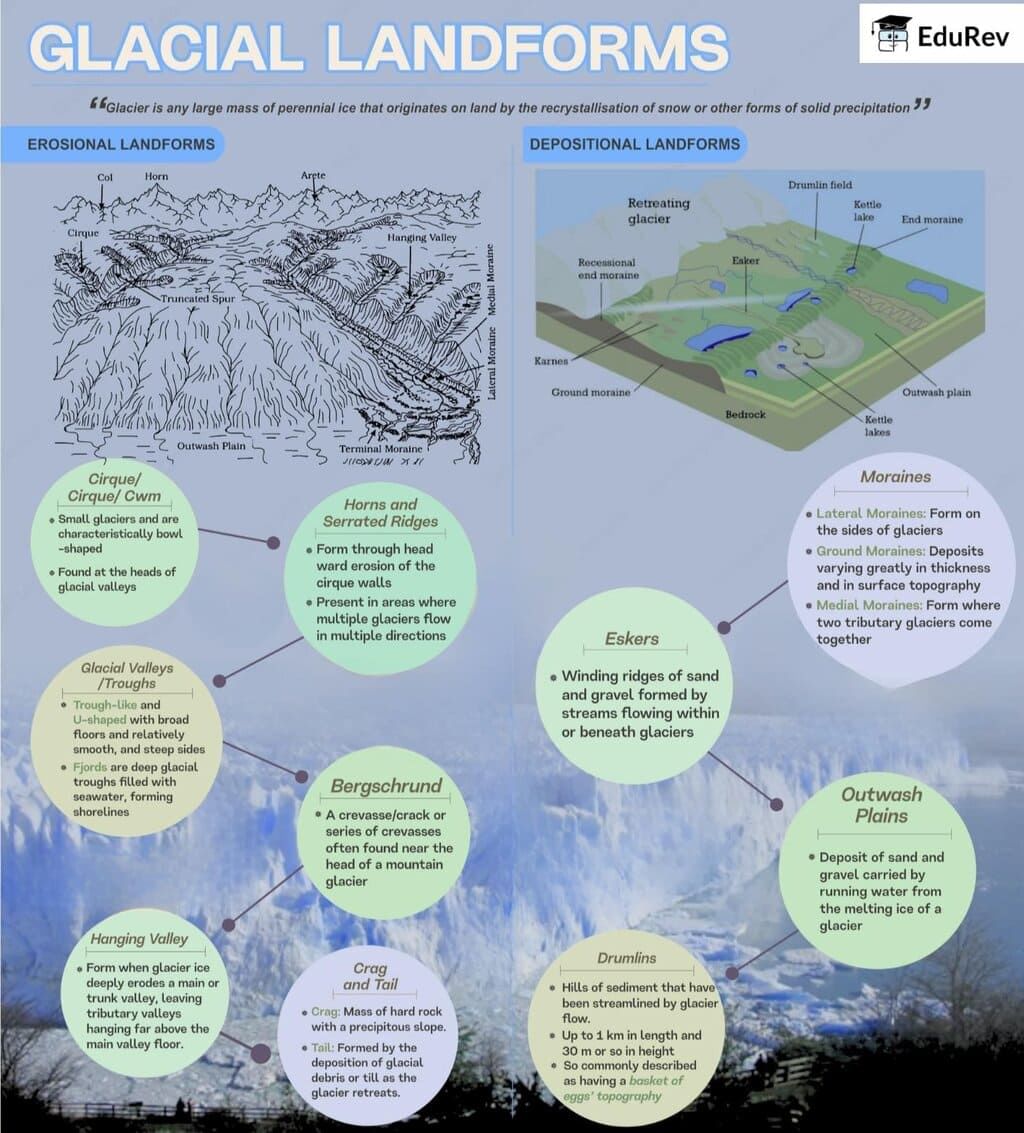UPSC Exam > UPSC Notes > Geography for UPSC CSE > Infographic: Glacial Landforms
Infographic: Glacial Landforms | Geography for UPSC CSE PDF Download

The document Infographic: Glacial Landforms | Geography for UPSC CSE is a part of the UPSC Course Geography for UPSC CSE.
All you need of UPSC at this link: UPSC
|
264 videos|875 docs|232 tests
|
FAQs on Infographic: Glacial Landforms - Geography for UPSC CSE
| 1. What are glacial landforms and how are they created? |  |
Ans. Glacial landforms are geographical features that are shaped by the movement and melting of glaciers. They are created through processes such as erosion, deposition, and weathering. As glaciers advance, they carve out valleys and shape mountains, forming features like U-shaped valleys, fjords, and cirques. When glaciers melt, they leave behind moraines, drumlins, and outwash plains, which are accumulations of sediment and debris.
| 2. What are the main types of glacial landforms? |  |
Ans. The main types of glacial landforms include:
1. <b>Cirques</b>: Bowl-shaped depressions formed at the head of a glacier.
2. <b>U-shaped valleys</b>: Valleys that have been widened and deepened by glacial erosion.
3. <b>Moraines</b>: Accumulations of debris deposited by glaciers, which can be terminal, lateral, or ground moraines.
4. <b>Drumlins</b>: Streamlined hills formed by glacial till.
5. <b>Fjords</b>: Deep, narrow inlets of the sea between high cliffs, formed by glacial erosion.
| 3. How do glacial landforms impact the environment? |  |
Ans. Glacial landforms significantly impact the environment by influencing local ecosystems, water flow, and soil composition. They create unique habitats for various species and affect drainage patterns, leading to the formation of lakes and rivers. Furthermore, glacial deposits enrich soils, promoting agriculture in some areas. The presence of glacial features can also attract tourism, which can lead to economic benefits for local communities.
| 4. What is the significance of studying glacial landforms in the context of climate change? |  |
Ans. Studying glacial landforms is crucial for understanding the effects of climate change. As glaciers retreat due to rising temperatures, they provide insights into past climate conditions and can serve as indicators of future environmental changes. The alteration of glacial landscapes can lead to increased flooding and changes in water resources, affecting human populations and ecosystems. Monitoring these changes helps in predicting and mitigating the impacts of climate change.
| 5. How do glacial landforms differ from other types of landforms? |  |
Ans. Glacial landforms differ from other landforms primarily in their formation process and characteristics. Unlike fluvial landforms shaped by rivers or aeolian landforms shaped by wind, glacial landforms are created by the intense pressure and movement of ice. They typically exhibit distinct features such as sharp ridges, deep valleys, and unique sediment deposits that are not commonly found in other landform categories.
Related Searches





















